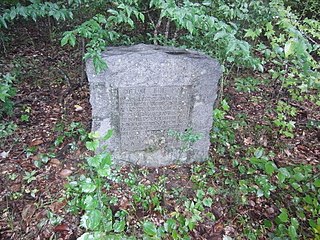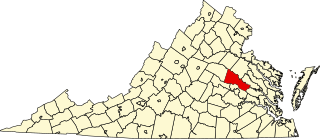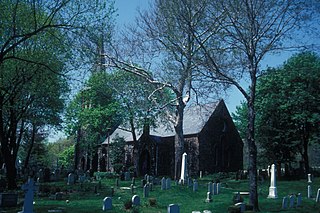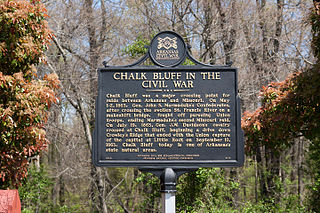
Dallas County is a county located in the central part of the U.S. state of Alabama. As of the 2020 census, its population was 38,462. The county seat is Selma. Its name is in honor of United States Secretary of the Treasury Alexander J. Dallas, who served from 1814 to 1816.

McIntosh,, is a town located in Washington County, Alabama, United States along U.S. Route 43. It is 12+1⁄2 miles (20.1 km) south of Wagarville and 44 miles (71 km) north of Mobile. The population as of the 2020 U.S. Census was 206, down from 238 in 2010.

Cedar Bluff is a town in Tazewell County, Virginia, United States. The population was 1,139 at the 2010 census. It is part of the Bluefield, WV-VA micropolitan area, which has a population of 107,578.

Cotton Gin Port is a ghost town in Monroe County, Mississippi, United States.

Cahaba, also spelled Cahawba, was the first permanent state capital of Alabama from 1820 to 1825. It was the county seat of Dallas County, Alabama until 1866. Located at the confluence of the Alabama and Cahaba rivers, the town endured regular seasonal flooding.

Pittstown is an unincorporated community located at the intersection of the boundaries of Alexandria, Franklin and Union townships in Hunterdon County, New Jersey. The area is named after William Pitt. The area is served as United States Postal Service ZIP Code 08867. The area was named Hofftown in the 18th century after landowner Lawrence Hoff. The Pittstown Historic District was listed on the state and national registers of historic places in 1990.

The Crocheron–McDowall House is a two-story Greek Revival-style house located in Bastrop, Texas, United States. The house was built in 1857 for wealthy New York merchant Henry Crocheron and his wife Mary Ann Tipple. Crocheron wanted a home that displayed his wealth, and built it with the finest-available materials and architectural decorations. After his death in 1874, Crocheron's niece Mary Ann McDowall inherited the property. She was an accomplished musician and held music classes at the residence. During the late 1800s, the residence was the social and intellectual center of Bastrop, and hosted prominent guests. The house was sold after McDowall died in 1933, since when the property has had several owners who have showed interest in preserving and restoring the property for its historical significance.

Bluff Hall is a historic residence in Demopolis, Alabama, United States. The original portion of the house is in the Federal style with later additions that altered it to the Greek Revival style. It was documented as part of the Historic American Buildings Survey in 1936, and added to the National Register of Historic Places in 1970. It serves as a historic house museum, with the interior restored to an 1850s appearance.
Prairieville is an unincorporated community in Hale County, Alabama, United States.

Verbena, also known as Summerfield, is an unincorporated community in southeastern Chilton County, Alabama, United States. Named for the indigenous flower, Verbena developed into a popular resort location for the more affluent citizenry of Montgomery, the state's capital, during the yellow fever outbreaks of the late 19th and early 20th centuries. Many stately homes, some of which have undergone recent renovation and restoration, line the streets of the town as a reminder of this historic past.

Lyon Hall, also known as the Lyon-Lamar House, is a historic Greek Revival mansion in Demopolis, Alabama, United States. It was built over a period of three years by George Gaines Lyon and his wife, Anne Glover Lyon. Lyon was an attorney and the nephew of Francis Strother Lyon, who maintained a residence nearby at Bluff Hall.
Sardis, also known as Berlin, is an unincorporated community in Dallas County, Alabama, United States.

Elm Bluff, also known as Centreport, Shepardsville, and Shepardville, is an unincorporated community in Dallas County, Alabama. It was named for the nearby bluff on the Alabama River and the closely associated Elm Bluff Plantation.

This is a list of the National Register of Historic Places listings in Hanover County, Virginia.

The William "Bill" Dannelly Reservoir is a reservoir created by Millers Ferry Lock and Dam on the Alabama River in Dallas County and Wilcox County in Alabama. It covers 27 square miles (70 km2) and has approximately 500 miles (800 km) of shoreline. It was named for William "Bill" Dannelly, a former Wilcox County probate judge credited with leading the modernization of the Alabama and Coosa Rivers.

This is a list of the National Register of Historic Places listings in Aiken County, South Carolina.
Meadow Bluff is an unincorporated community in Greenbrier County, West Virginia, United States. Meadow Bluff is 4.5 miles (7.2 km) southeast of Rupert.

The Church of St. Andrew is a historic Episcopal church located at Arthur Kill and Old Mill Roads on the north side of Richmondtown in Staten Island, New York.

Elm Bluff is a historic former forced-labor farm and plantation house in the rural community of Elm Bluff, Dallas County, Alabama, United States. Situated on a bluff high above the Alabama River, the now near-ruinous house is considered by architectural historians to be one of the most refined and unusual Greek Revival-style houses in the state.

Chalk Bluff was an unincorporated community in Clay County, Arkansas, United States, approximately two miles (3 km) northwest of St. Francis. The town was formed in the 1820s at the point where the St. Francis River cuts through Crowley's Ridge from west to east. The name of the community was derived from the white clay bluff created by this crossing. The founder of the community was Abraham Seitz, who established and operated a ferry crossing and general store in the area from the 1830 until it was destroyed during the Civil War. The community occupied a strategic location and was often referred to in the reports of Union and Confederate forces vying for control of Northeast Arkansas during the war. Several skirmishes occurred near the ferry crossing, one of which was significant it enough to become known as the Battle of Chalk Bluff, which took place in early May 1863. The town was abandoned following the Civil War and most residents moved to the new railroad town, St. Francis, Arkansas. The location was listed on the National Register of Historic Places in 1974.


















